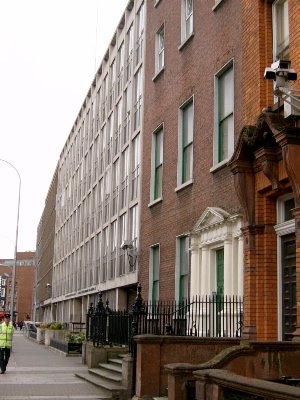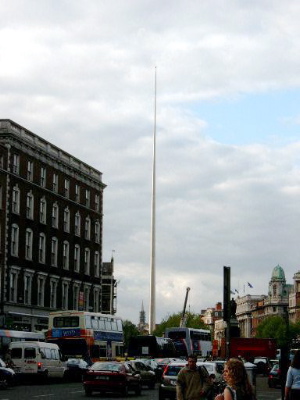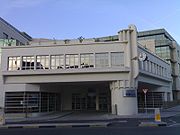
Development and preservation in Dublin
Encyclopedia

Georgian era
The Georgian era is a period of British history which takes its name from, and is normally defined as spanning the reigns of, the first four Hanoverian kings of Great Britain : George I, George II, George III and George IV...
, it acquired a beautiful and distinctive style of architecture. However, since the 1960s, Dublin has been massively re-developed, sometimes at the cost of its architectural heritage. There have been repeated controversies about what is sometimes termed "cultural vandalism" — i.e. destructive or insensitive development in the city. The first such disputes date back to the 1950s, the latest (was over Carrickmines Castle
Carrickmines Castle
Carrickmines Castle is an archaeological site in Carrickmines, County Dublin, in eastern Ireland. The castle was built in the medieval period to protect the English-ruled Pale around Dublin...
) (2005).
Georgian Dublin
In 1932, Éamon de ValeraÉamon de Valera
Éamon de Valera was one of the dominant political figures in twentieth century Ireland, serving as head of government of the Irish Free State and head of government and head of state of Ireland...
, senior survivor of the 1916 Easter Rising
Easter Rising
The Easter Rising was an insurrection staged in Ireland during Easter Week, 1916. The Rising was mounted by Irish republicans with the aims of ending British rule in Ireland and establishing the Irish Republic at a time when the British Empire was heavily engaged in the First World War...
and leader of the defeated anti-treaty forces in the Civil War, won power at the ballot box. With greater finances available, major changes began to take plgayace. A scheme of replacing tenements with decent housing for Dublin's poor began. Plans were proposed for the wholesale demolition of many buildings from the Georgian era, often because they were thought 'old-fashioned' and 'near the end of their life', often because they were seen as symbols of past English and British rule. The Viceregal Lodge
Viceregal Lodge
Viceregal Lodge may refer to:Residences of the Lord Lieutenant of Ireland:* Áras an Uachtaráin, Dublin * Chapelizod House, County Dublin Residences of the Viceroy of India:* Rashtrapati Niwas, Simla...
was proposed for demolition, to make way for a new residence for the new office of President of Ireland
President of Ireland
The President of Ireland is the head of state of Ireland. The President is usually directly elected by the people for seven years, and can be elected for a maximum of two terms. The presidency is largely a ceremonial office, but the President does exercise certain limited powers with absolute...
, an office created in Bunreacht na hÉireann, the new Irish constitution of 1937 which renamed the Irish Free State Éire
Éire
is the Irish name for the island of Ireland and the sovereign state of the same name.- Etymology :The modern Irish Éire evolved from the Old Irish word Ériu, which was the name of a Gaelic goddess. Ériu is generally believed to have been the matron goddess of Ireland, a goddess of sovereignty, or...
. Merrion Square, with its large Georgian mansions, was proposed for demolition, to be replaced on its three sides by a national museum, national Roman Catholic cathedral and national art gallery. Though plans were made, few were put into effect and those not implemented were put on hold when in September 1939 Hitler
Adolf Hitler
Adolf Hitler was an Austrian-born German politician and the leader of the National Socialist German Workers Party , commonly referred to as the Nazi Party). He was Chancellor of Germany from 1933 to 1945, and head of state from 1934 to 1945...
invaded Poland and the Second World War began. Dublin escaped the mass bombing of the war due to Ireland's neutrality
Irish neutrality
Ireland has a "traditional policy of military neutrality". In particular, Ireland remained neutral during World War II, and has never been a member of NATO or the Non-Aligned Movement. The formulation and justification of the neutrality policy has varied over time...
, though some bombs were dropped by the German air-force
Luftwaffe
Luftwaffe is a generic German term for an air force. It is also the official name for two of the four historic German air forces, the Wehrmacht air arm founded in 1935 and disbanded in 1946; and the current Bundeswehr air arm founded in 1956....
and hit North Strand
North Strand
North Strand is an area of the inner city on the Northside of Dublin, Ireland. The area is bounded roughly by East Wall to the east, Ballybough to the northwest, and Fairview to the north...
a working-class district.
By 1945, the planned wholesale destruction of Georgian Dublin were abandoned and the Viceregal Lodge (renamed in 1938 Áras an Uachtaráin
Áras an Uachtaráin
Áras an Uachtaráin , formerly the Viceregal Lodge, is the official residence of the President of Ireland. It is located in the Phoenix Park on the northside of Dublin.-Origins:...
) was restored as a presidential palace. (The Irish state was also in effect renamed in 1949, becoming either simply Ireland or the Republic of Ireland
Republic of Ireland
Ireland , described as the Republic of Ireland , is a sovereign state in Europe occupying approximately five-sixths of the island of the same name. Its capital is Dublin. Ireland, which had a population of 4.58 million in 2011, is a constitutional republic governed as a parliamentary democracy,...
). However, from the 1950s onwards, Georgian Dublin came under concerted attack by Irish Government development policies. While Georgian Dublin survived 1930s plans and World War II, much of it did not survive property developers in the 1960s, 1970s and 1980s. The historic but now impoverished Mountjoy Square suffered heavily, with derelict sites replacing historic mansions. When in the 1950s a row of large Georgian houses in Kildare Place near Leinster House was demolished to make way for a brick wall an extreme republican Fianna Fáil
Fianna Fáil
Fianna Fáil – The Republican Party , more commonly known as Fianna Fáil is a centrist political party in the Republic of Ireland, founded on 23 March 1926. Fianna Fáil's name is traditionally translated into English as Soldiers of Destiny, although a more accurate rendition would be Warriors of Fál...
minister, Kevin Boland
Kevin Boland
Kevin Boland , was a senior Irish politician. He was first elected to Dáil Éireann in 1957 as a Fianna Fáil TD. He served as Minister for Defence , Minister for Social Welfare and Minister for Local Government...
celebrated, saying that they had stood for everything he opposed. He also condemned the leaders of the Irish Georgian Society
Irish Georgian Society
The Irish Georgian Society aims to encourage an interest in and to promote the conservation of distinguished examples of architecture and the allied arts of all periods in Ireland...
, established to battle to preserve Georgian buildings and some of whom came from aristocratic backgrounds, as "belted earls". In the 1960s, the world's longest line of Georgian buildings was interrupted when the ESB
Electricity Supply Board
The Electricity Supply Board , is a semi-state electricity company in Ireland. While historically a monopoly, the ESB now operates as a commercial semi-state concern in a liberalised and competitive market...
was allowed to demolish a chunk in the centre and build a modern office block. By the 1980s, road-widening schemes by Dublin Corporation ran through some of the most historic areas of the inner city around Christ Church Cathedral. The nadir of this approach occurred in 1979 when Dublin Corporation destroyed the largest and finest Viking site in the world at Wood Quay
Wood Quay
Wood Quay is a riverside area of Dublin that was a site of Viking settlement. Dublin Corporation acquired Wood Quay gradually between 1950 and 1975, finally announcing that it would be the location of their new offices. Finds made during the initial excavation of the site led to a massive, but...
, in the face of national opposition, to build its Civic Offices for its public servants.
The 1980s—A Change in Policy

By the 1990s a greater civic pride and a new management team in Dublin Corporation saw changes in how the city was run; among the results was the restoration of City Hall to its eighteenth century interior (removing Victorian and Edwardian additions and rebuilds), and the replacement of the famed Nelson's Pillar
Nelson's Pillar
The Nelson Pillar , known locally as Nelson's Pillar or simply The Pillar, was a large granite pillar topped by a statue of Horatio Nelson in the middle of O'Connell Street, Dublin...
(a monument on O'Connell Street which had dominated the skyline until being blown up in 1966 by republicans) by a new Spire of Dublin
Spire of Dublin
The Spire of Dublin, officially titled the Monument of Light is a large, stainless steel, pin-like monument in height, located on the site of the former Nelson's Pillar on O'Connell Street in Dublin, Ireland.-Details:...
, the world's tallest sculpture, on the site of the old Pillar and which could be seen throughout the city.
Temple Bar
The new awareness was also reflected in the development of Temple Bar, the last surviving part of Dublin that contained its original medieval street plan. As late as the mid 1980s, Temple Bar was seen as a poor, run down segment of the city, stretching in terms of length from the Old Houses of Parliament in College GreenCollege Green
College Green is a three-sided "square" in the centre of Dublin. On its northern side is a building known today as the Bank of Ireland which until 1800 was Ireland's Parliament House. To its east stands Trinity College Dublin, the only constituent college of the University of Dublin. To its south...
to Parliament Street, which faced City Hall, and which in terms of width stretched from Dame Street to the city quays. In the 1970s, Córas Iompair Éireann
Córas Iompair Éireann
Córas Iompair Éireann , or CIÉ, is a statutory corporation of the Irish state, answerable to the Irish Government and responsible for most public transport in the Republic of Ireland and, jointly with its Northern Ireland counterpart, the Northern Ireland Transport Holding Company, between the...
(CIÉ), the state transport company, bought up many of the buildings in this area, with a view to building a large modern central bus station on the site, in the process replacing the medieval streets and buildings (while the street pattern was medieval, most of the buildings were not, dating from the eighteenth or nineteenth century) by one large bus station with a shopping centre attached. However, delays in providing the financing led CIÉ to rent out the buildings at nominal rents. Most of the buildings were rented by artists, producing a sudden and unexpected appearance of a 'cultural quarter' that earned comparisons with Paris's Left Bank. Though CIÉ remained nominally committed to its planned redevelopment, the vibrancy of the Temple Bar area led to demands for its preservation. By the late 1980s, the bus station plans were abandoned and a master plan put in place to maintain the Temple Bar's position as Dublin's cultural heartland.
That process has been a mixed success. While the medieval street plan has survived, rents have rocketed, forcing the artists elsewhere. They have been replaced by restaurants and a proliferation of bars which draw thousands of tourists but which has been criticised for over commercialisation and excessive alcohol consumption. Some of the more historic buildings in the area have been destroyed in this process, notably St. Michael and John's Roman Catholic Church, one of the city's finest and oldest Catholic church, which predated the repeal of the Penal Laws and Catholic Emancipation
Catholic Emancipation
Catholic emancipation or Catholic relief was a process in Great Britain and Ireland in the late 18th century and early 19th century which involved reducing and removing many of the restrictions on Roman Catholics which had been introduced by the Act of Uniformity, the Test Acts and the penal laws...
. Its interior was gutted to be replaced by a tourist-orientated "Viking adventure centre" which ran into financial problems. While the development of Temple Bar was far preferable to its obliteration under a 1980s multi-story bus station, many people have criticised some aspects of its development, arguing that the new Temple Bar tourist area has failed to show sufficient sensitivity to the potential that had existed. Temple Bar was used as a set for some of the exterior scenes in the film Far and Away
Far and Away
Far and Away is a 1992 adventure-drama-romance film directed by Ron Howard from a script by Howard and Bob Dolman, and stars Tom Cruise and Nicole Kidman. Cinematography by Mikael Salomon, with a music score by John Williams...
.
Between December 2002 and January 2003, the Dublin Spire was erected on O'Connell Street
O'Connell Street
O'Connell Street is Dublin's main thoroughfare. It measures 49 m in width at its southern end, 46 m at the north, and is 500 m in length...
. A 120 m tall tapered metal pole, it is the tallest structure of Dublin city centre, visible for miles. It was assembled from seven pieces with the largest crane
Crane (machine)
A crane is a type of machine, generally equipped with a hoist, wire ropes or chains, and sheaves, that can be used both to lift and lower materials and to move them horizontally. It uses one or more simple machines to create mechanical advantage and thus move loads beyond the normal capability of...
available in Ireland. It replaces Nelson's Pillar which was blown up in 1966.
The Archer's Garage Incident

See also
- History of DublinHistory of DublinThe City of Dublin can trace its origin back more than 1,000 years, and for much of this time it has been Ireland's principal city and the cultural, educational and industrial centre of the island.-Founding and early history:...
Archer's Garage Thread - http://www.archiseek.com/content/showthread.php?t=420

